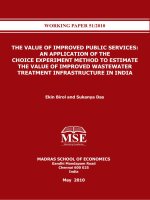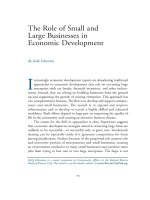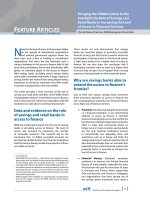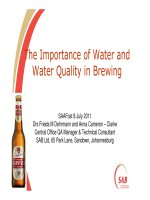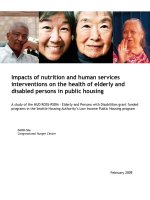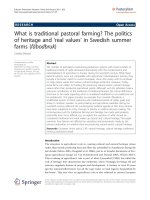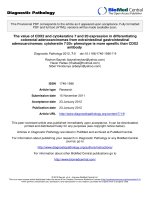the value of switching and growth options in foreign direct investmentl
Bạn đang xem bản rút gọn của tài liệu. Xem và tải ngay bản đầy đủ của tài liệu tại đây (585.47 KB, 137 trang )
THE VALUE OF SWITCHING AND GROWTH OPTIONS
IN FOREIGN DIRECT INVESTMENT
DISSERTATION
Presented in Partial Fulfillment of the Requirements for
the Degree of Doctor of Philosophy
in the Graduate School of The Ohio State University
By
Sangcheol Song, M.S.
*****
The Ohio State University
2008
Dissertation Committee: Approved by
Professor Mona Makhija, Advisor
_______________________
Professor Jay Barney Advisor
Professor Benjamin Campbell Business Administration Graduate Program
II
ABSTRACT
According to real options theory, foreign direct investments can be structured in
ways that allow firms flexibility under environmental uncertainty. Through the options
built into these investments, multinational companies can capture upside opportunities
and contain downside risks stemming from the environment. Prior empirical studies on
real options investments, however, have shown mixed or inconclusive results about the
real options value of foreign direct investment. In this dissertation we argue that this may
be due to the fact that these studies do not fully take into account the different types of
environmental uncertainty faced by firms, the potentially contradictory interplay among
different types of options embedded in an investment, and/or managerial costs of
creating and managing real options. The purpose of this dissertation is to address these
problems in the multinational flexibility literature.
In the main essay, ‘Growth and Switching Options in Foreign Direct Investments,’
we examine in greater depth the two important perspectives of real options associated
with foreign direct investments, growth and switching. We show that the ability to derive
growth and switching options depends on the way in which foreign direct investments
are configured across countries. Furthermore, these configurations of foreign direct
investments are argued to have different theoretical implications for firm value under
different types of host country uncertainty. Using panel data of Korean foreign direct
III
investment during the period 1991-2004, a period encompassing varying conditions of
uncertainty in host countries, we find that, consistent with our expectations, firms with
switching options (gained through highly dispersed operations and higher levels of
ownership across countries) were associated with higher value in periods of higher
exchange rate uncertainty than those without such options. As predicted, we also find
that firms with growth options (gained through concentrated presence of subsidiaries in
specific countries and lower levels of ownership) were associated with higher value in
conditions of host market uncertainty than firms without such option.
Additionally, we found that greater cultural distance between host and home
countries within the international network reduces the value of switching options, most
likely due to the additional transactions costs associated with it. On the other hand,
higher ownership levels lessen this negative impact of cultural distance. The findings
associated with ownership and cultural distance within the firm’s international network
point to the relevance of managerial control and coordination within the realm of real
options. Finally, we found evidence supporting the notion that firms make future
investment choices based on their expected needs for real options. When firms desire
switching options, we find that they add to their breadth by establishing a new subsidiary
in new countries. When the need for growth options is greater, they add a new subsidiary
in countries in which they already have investments.
IV
Dedicated to my parents, my sister and two brothers, and nieces and nephews
V
ACKNOWLEDGMENTS
My special thanks are reserved for Professor Mona Makhija. Her kind endurance
and warm-hearted encouragement have enabled me to run to the finish line of my
doctoral program. Professors Jay Barney, Jay Anand, Seung-hyun Lee, and Banjamin
Campbell, Mikelle Calhoun have guided me through my coursework and dissertation
work. Their ardent love for teaching and research has stimulated my academic journey to
more interesting and new questions in my field.
Having arrived at this juncture in my life, I would also like to share my delight and
thanks with my lovely parents, sister, two brothers, four nieces and two nephews at Korea.
Their inherent love for me and unhesitant support of my academic pursuits in the United
States empowered me in every moment I experienced of disappointment and depression.
The support and prayers of Pastor Sung-jin Hong and the Handul church family will be
forever cherished in my mind. God and Jesus Christ raised me up more than I could do
myself in every step of the Ph.D. program.
Financial and administrative support from The Ohio State University and the Fisher
College of Business is also greatly appreciated.
VI
VITA
February 6, 1972 Born- Buan, Korea
1992 – 1996 B.A., Yonsei University, Seoul, Korea
1996 – 1998 MBA, Yonsei University, Seoul, Korea
1998 – 2001 Teaching officer, Korean Third Military Academy, Korea
2001 – 2004 Korea Development Bank, Seoul, Korea
2004 – 2008 Graduate Research/Teaching Assistant, The Ohio State University
PUBLICATIONS
1. Song, S., Makhija, M., and Lee, S., 2008. Growth and Switching Options
in Foreign Direct Investments, Academy of Management 2008 Annual Conference
Best Paper Proceedings, Anneheim, USA (Also nominated as one of four finalists
for the Samsung Distinguished Paper).
2. Song, S. 2007. Two Contradictory Effects of Prior Experience on Early Exits of
Partially-owned Firms,” Hayes Research Forum Proceedings, The Ohio State
University, 2007. Volume 7.
3. Song. S. 1999. The Effect of Resource Types and Ownership Share Levels on
Ownership Change: The Bargaining Power Perspective (in Korean), Korean
Academy of International Business, Korea (Awarded as Best Master’s Thesis)
FIELDS OF STUDY
Major Field: Business Administration (International Business)
VII
TABLE OF CONTENTS
Page
Abstract……….…………………………………………………………………… … ⅱ
Dedication…… …………………………………………………………………… … ⅳ
Acknowledgments…….…………………………………………………….……………ⅴ
Vita………………………………………………………….……………………………ⅵ
Table of Contents……….……………… ……………………………………………ⅶ
List of Tables …………… …………………………………………………………… ⅸ
List of Figures………………………………………………………………………… ⅹ
Chapters:
1. Purpose of this Dissertation…………………………………………………………….1
2. Review of the Literature on Real Options and Foreign Direct Investments ………… 6
2.1 Introduction…………………………………………………………………………6
2.2 Key Components of Real Options Theory………………………………………….8
2.3 Management and Implementation of Real Options………………………….……27
3. Need for Future Research…………………………………………………………… 43
3.1 Motive for the Research 43
3.2 Theoretical Underpinnings 48
VIII
4. Conceptual Model and Hypotheses 56
4.1 Conceptual Model 56
4.2 Hypotheses 57
5. Research Methodology 69
5.1 Data 69
5.2 Dependent variables 70
5.3 Independent variables 71
5.4 Control variables 76
5.5 Analytical procedures 80
6. Research Findings and Discussion 83
6.1 Research Findings 83
6.2 Discussion of Findings 93
7. Conclusions and Implications 105
7.1 Conclusions 105
7.2 Implications 108
References
IX
LIST OF TABLES
Table Page
2.1 Uncertainty Types in Real Option Literature………………… …… …… ……36
2.2 Investment Types in Real Options Literature……… ……………………… …….38
2.3 Delayability and the Boundary of Real Options Theory……… …………… ……39
2.4 Timing and value of Exercising Real Options……………………………… …40
2.5 Options Types in Real Option Literature………………………………………… 41
2.6 Performance Measures in Real Options Literature…………….………… …… …42
3.1 Two Option Relating to FDI…… …… ……………………………………… …55
6.1 Descriptive Statistics and Correlation Matrix.………….………………… ….… 98
6.2 Selection Model 1…………………………………………………………… 99
6.3 Selection Model 2……………………………………………………………….….100
6.4 Results for Hypothesis Tests…………………………………… …………… …101
6.5 Effects of Cultural Distance…………… …………….……………………….….103
6.6 Firm’s Behavioral Choice: Increase in Breadth and Depth…….…………… 104
X
LIST OF FIGURES
4.1 Conceptual Model………………………………………………………… … 68
1
CHAPTER 1
PURPOSE OF THIS DISSERTATION:
THE REAL OPTIONS VALUE OF FOREIGN DIRECT INVESTMENTS
Real options theory suggests that under conditions of high uncertainty, firms can
use various types of strategic investments to “keep their options open” (Bowman and
Hurry, 1998; Dixit, 1989; Dixit and Pindyck, 1994; Kogut, 1991; McDonald and Siegel,
1986). Real options can enable a firm to monitor the business situation in a particular
market or industry at relatively low cost. The upside potential of option-like investments
can be very high, whereas the cost of developing and managing the investment, including
the cost of canceling it should it turn out to have limited value, is assumed to be quite
low. Based on these arguments, real options logic has become an important theoretical
tool in analyzing the value of an investment under high uncertainty.
Scholars have noted that foreign direct investments are also a type of investment
potentially associated with real options that provide firms with flexibility under
uncertainty (Campa, 1993; Kogut, 1991; Rangan, 1998; Tong and Reuer, 2007). In this
regard, a priori investments allow firms preferential access to future opportunities and
reduction of downside risks in specific countries by allowing them to adapt their
investments specifically in line with the evolving environment, or sequence their
2
investment over time as they gain knowledge about the local environment. The issue of
uncertainty is particularly important in the international context, in that multinational
firms are exposed to considerable uncertainty stemming from different sources, such as
exchange rate volatility, unanticipated fluctuations in consumer demand or economic
conditions, political risk or unexpected policy changes that substantially affect firm
profits, or other unforeseen transformations in the country’s institutional environment.
When faced with high uncertainty, then, firms can structure foreign direct investments “to
keep their options open” (Cuypers and Martin, 2006; Kogut, 1991; Tong and Reuer,
2007).
A real options perspective has been applied to foreign direct investment in several
areas of research, including timing of foreign entry (Campa, 1994; Rivoli and Salario,
1996), mode of foreign entry (Cupyers and Martin, 2006; Folta, 1998; Tong, Reuer, and
Peng, 2007), value of multinationality or international joint ventures (Chi, 2000; Chi and
McGuire, 2000; Reuer and Leiblein, 2000; Tong, Reuer, and Tong, 2007; Tong and
Reuer, 2007), as well as the timing, conditions, and value of foreign exit (Folta and
Miller, 2002; Kogut, 1991; Kumar, 2005). Although the literature on multinational
flexibility has shed considerable light on why and how firms invest and structure their
foreign operations, much of the findings in this regard are mixed and divergent. For
example, while some researchers have shown that multinationality generates additional
value through the increased flexibility it affords (E.g. Allen and Pantzalis, 1996; Kogut,
3
1991; Lee and Makhija, 2008; Tang and Tikoo, 1999), other researchers do not find that
international investments yield real options benefits because of multinational complexity
and non-trivial costs of management (Reuer and Leiblein, 2000). While some have shown
that dispersed operations across national borders have a linear and positive relationship to
firm value (Allen and Pantzalis, 1996; Huchmerier and Cohen, 1996; Tang and Tikoo,
1999), others have shown a negative relationship to firm value and performance (Lee and
Makhija, 2008). Still others have found a non-linear relationship to real options value, as
in the case of Tong and Reuer (2007), who uncovered an inverted U-shaped relationship
between multinationality and downside risk reduction. The diversity of these findings
points to the need for a more fine-grained investigation of the real options perspective in
relation to foreign direct investments.
In uncovering the reason for these divergent findings, we find that several
assumptions made in the current literature are problematic. First, some researchers (E.g.
Allen and Pantzalis, 1996; Tang and Tikoo, 1999; Tong and Reuer, 2007) have only
assumed that the international context is associated with high levels of uncertainty, and
do not actually measure it in any fashion. These studies therefore assume that foreign
direct investments are always associated with real options value under any conditions.
These assumptions are of concern, however. Since uncertainty is the most important
component of real options logic, without which the value of flexibility to the firm is
4
highly diminished, we argue that it should be incorporated explicitly and investigated
carefully. In this regard, it should be recognized that different forms of uncertainty may
be faced the multinational firm, influencing in specific ways the nature of strategies it
uses, the structures adopted, and performance achieved.
A second concern is that, although the theoretical literature clearly indicates that
foreign direct investments can potentially provide multiple types of options to the firm,
most of the empirical studies to date assume and study only one option type at a time.
The problem with this assumption is that different options may co-exist within the firm’s
portfolio of international investments. These different options, which may include options
to defer, invest, or switch, may be valuable at different times or only under specific
conditions. That is, some investments in the portfolio may yield one type of option while
others another type of option, and in this sense, lead to contradictory effects within the
portfolio which may cancel out the positive and/or significant effects of any given option.
It is important, therefore, to examine and take into account the interplays between
different options within a firm’s investment portfolio.
An additional assumption commonly seen in the extant literature is that firms are
able to control and coordinate their foreign operations as necessary. That is, it is assumed
that once option-like investments are in place, multinational flexibility will be achieved
automatically. It may be not, however, easy to gain control and coordination over far-
flung foreign subsidiaries due to multinational complexity and organizational constraints.
5
Firms may be unable to use the options embedded in these subsidiaries in a timely
or efficient manner due to organizational factors that impede their control of these
investments. We argue, for this reason, that it is also important to take into consideration
the issues that influence the issues surrounding the management of real options
investments.
Finally, the literature has tended to assume that the costs of creating and managing
real options are quite low. This, in fact, is an important assumption, since low costs of a
priori investments are a primary source of value associated with real options investments.
What if, however, the costs are not so low under some circumstances? What if the costs
of creating and managing real options are positively correlated with the values of the
investments? How would this affect managerial decision making? The problem is that
little effort has been devoted thus far in the literature to examining the relationship
between costs of real options investments and the value generated from them. We argue
that these managerial costs may lead to very different decisions on foreign entry and exit
from those argued in the current literature.
The goal of this dissertation is to address the problems discussed above that are
associated with the extant literature that has applied a real options lens to foreign direct
investments. To begin, we review the prior literature on real options theory in the next
chapter, in order to establish the main assumptions of this literature in greater depth and
to examine the need for future work in this regard.
6
CHAPTER 2
A REVIEW OF THE LITERATURE ON REAL OPTIONS
AND FOREIGN DIRECT INVESTMENTS
2.1 Introduction
Real options theory has become an important theoretical tool in understanding the
strategies of a firm facing high uncertainty. This theory suggests that under conditions of
high uncertainty, firms can use various types of strategic investments to “keep their
options open” (Bowman and Hurry, 1998; Dixit, 1989; Dixit and Pindyck, 1994; Kogut,
1991; McDonald and Siegel, 1986). Multinational firms in particular are exposed to
many significant forms of uncertainty, including unanticipated fluctuation in the relative
value of currencies, unexpected changes in demand for their products, and institutional
disruption (Allen and Pantzalis, 1996; Campa, 1993; Cuyper and Martin, 2006; Kogut
and Chang, 1996; Makhija, 1993; Miller, 1998; Tong and Reuer, 2007). To help them
deal with such uncertainty, their foreign direct investments may embody real options in
that they preserve future decision rights for the firm (Kogut, 1991; McGrath and Nerkar,
2004; Tong and Reuer, 2007).
7
That is, they may contain significant upside potential due to the firm’s preferential
access to future growth opportunities embedded in the foreign environments in which
they operate. They may also reduce downside risks by allowing the firm to switch
production or sales across countries in response to macroeconomic changes in any given
country (Kogut, 1991; Kogut and Kulatilaka, 1994; Allen and Pantzalis, 1996; Tang and
Tikoo, 1999; Tong and Reuer, 2007; Tong, Reuer, and Peng, 2007). In this way, foreign
direct investments have the ability to provide the firm with valuable flexibility under
uncertainty.
The purpose of this chapter is to review the extant literature on real options theory
with a special focus on the real options associated with foreign direct investment. We
begin analyzing key components of real options theory in order to understand how real
option logic works. We will show how real options theory contributes significantly to
our understanding of how firms can invest in specific ways in order to address the
uncertainty they face, and the particular role of foreign direct investments in this regard.
In this respect, we conduct a thorough examination of the theoretical and empirical
literature in relation to foreign direct investment. In doing so, we identify areas for future
research in the literature.
8
2.2 Key Components of Real Options Theory
2.2.1. The Issue of Uncertainty
Uncertainty can be characterized as situations where firms cannot anticipate future
developments due to randomness or arbitrariness of events in the environment, resulting
in an inability to assess in advance the value of an investment. Real option theorists have
focused on such exogenous uncertainty as the key driver of the value real options
investments. More specifically, exogenous uncertainty refers to the volatility of the
economic returns caused by unpredictability of the external environment (Chi, 2000;
Dixit and Pindyck, 1994; Folta, 1998). Importantly, the creation and resolution of this
volatility is unaffected by the actions of the firm (Roberts and Weitzman, 1981; Chi and
Seth, 2001). For example, uncertainty associated with currency exchange rates is
exogenous to the firm since these rates are determined in atomistic markets (Campa,
1994).
Uncertainty of this sort is also abnormal, which means that there must be
recognizable variance in the uncertainty before and after a critical point (such as an event
or shock). The economic crisis that took place in Asian countries in 1997 is an example
of this sort (Chung and Beamish, 2004; 2005; Lee and Makhija, forthcoming). The
unpredictability of a firm’s external environment may be due to movements in
9
macroeconomic factors that are determined in a complex system involving uncountable
forces within the markets as well as the behaviors of sovereign governments. Uncertainty
over the economic value of an exchange, including that relating to price, markets, and
technology, is the issue of concern to firms investing in real options (Copeland and
Kennan, 1998; Folta, 1998; Kogut, 1991; Kulatilaka and Wang, 1996; Kumar, 2005;
Roemer, 2004; Sanchez, 2003; Vassalo, Anand, and Folta, 2004).
Note that, while exogenous uncertainty is a key element in the real options
argument, endogenous uncertainty is not an important issue in this regard. According to
this perspective, endogenous uncertainty is resolved (at least in part) by the actions of the
firm (e.g. by engaging in more learning) over time (Chi and Seth, 2001; Cuypers and
Martin, 2006; Folta, 1998; Roberts and Weitzman, 1981). In making the point that real
options logic does not hold for endogenous uncertainty, Cuypers and Martin (2006) noted
since only investing will reveal the relevant information under uncertainty so that it can
be resolved endogenously, there exists an incentive to invest and commit resources rather
than to wait (Roberts and Weitzman, 1981; Smit and Trigeorgis, 2004). Regarding the
relationship between uncertainty, learning, and the boundary of real options, it is argued
that as a consequence of the open-ended nature of this learning process, the discrete
nature of real options investment is eroded, which creates serious organizational
challenges in preserving the flexibility that made the real options investment attractive
(Adner and Levinthal, 2004a; Cuypers and Martin, 2006).
10
Considering the importance of uncertainty as the key driver of real options value, it
is necessary to identify and measure uncertainty under appropriate contexts. In this regard,
it is also important to precisely capture unexpected changes in the main sources of
uncertainty. A number of different methods have been used for this purpose in the real
options literature. For example, Kogut (1991) captured unexpected change in the product
market, measured as the difference between actual and forecasted shipment growth rates.
Consistent with this, Hauser (2004) criticized the traditional standard deviation method of
computing volatility since it does not capture ‘unexpected volatility.’ Instead, he took
into account expectations of future exchange rates to get an appropriate exchange rate
risk measure which captures the unexpected deviations of the current spot exchange rate
from its expected value, using a second order autoregressive equation with a time trend
for each country derived from monthly data of real exchange rates taken from
Datastream.
1
Folta and O’Brien (2004), and Folta, Johnson, and O’Brien (2005) pointed
out that other measures fail to account for the potential trends in data and also for
possible heteroskedasticity. In their own research they use the conditional variance
generated from generalized autoregressive conditional heteroskedasticity (GARCH)
1
Hauser (2004) used a second order autoregressive equation with a time trend for each country j from
monthly data, exrjt = a + b · trendj + c · exrjt−1 + d · exrjt−2 +_jt (2.1) where exrjt−x is the nominal
exchange rate in country j at time (month) t−x (x = 0, 1, 2), _jt is the error term of this regression equation
and a, b, c, d are coefficients to be estimated. The standard deviation of the monthly residuals is calculated
for each year and each country. In order to account for the level of the exchange rate, the standard deviation
is normalized by the mean exchange rate. As we will show in our methods chapter, this is the method we
adopt as well.
11
models, which they argue captures the uncertainty (i.e., that which is not predictable
regarding a trend) that might exist for each period in the time series. Table 1 summarizes
several types of uncertainty currently examined in the real options literature.
It is also important to consider not only individual sources of uncertainty but
potential correlations among multiple sources of uncertainty. Kogut and Kulatilaka
(1994) also points out the impacts of possible correlations of uncertainty on overall
volatility and real options value. This issue comes into play due to the typical approach
of real options scholars to only consider a single source of uncertainty in their analyses.
Doing so suggests the assumption that potential correlations among different sources of
uncertainty faced by the firm are not significant, and therefore, do not need to be taken
into account. It is worthwhile, however, to revisit this assumption of little correlation of
the sources of uncertainty. For instance, during the Asian economic crisis in 1997, at
least ten countries in the East Asian region of the world had significant unexpected
plunges in the value of their currencies at approximately the same time. Analysts have
suggested that some, albeit not all, of the causes underlying this downturn in currency
value were similar. This case clearly shows that a relatively large region of the world,
encompassing multiple countries, can have highly correlated uncertainty. Since South
Korea (hereafter, Korea) was one of these countries, it is possible that Korean firms may
have tried to address this uncertainty using investments in other countries, including
12
those in other Asian countries. However, since other crisis-stricken countries (e.g.
Malaysia, Philippine, Thailand, and Indonesia) experienced currency change in the same
direction as the Korean currency, Korean firms would be unable to generate significant
flexibility from their investments located in these countries as compared to those located
in other non-crisis countries.
In addition to correlations within a given type of uncertainty, such as exchange
rate uncertainty, correlations among different types of uncertainty should also be taken
into consideration. For example, Goldberg and Kolstad (1995) take the correlation
between export demand and exchange rate shocks into consideration, saying that if non-
negative correlation exists between export demand and exchange rate shocks, the
multinational company should optimally locate some productive capacity. This is due to
the fact that producing abroad helps to insulate the firm from currency related
uncertainty. Indeed, we would expect that the capacity share located abroad increases as
exchange rate volatility rises and becomes more correlated with export demand shocks.
As can be seen from our discussion above, the practice of using country as a
boundary condition in operational flexibility may in fact overvalue actual flexibility.
Interestingly, however, past studies have tended to rely on country context as the
boundary condition in their analyses (e.g. Pantzalis, Simkins, and Laux, 2001; Allen and
Pantzalis, 1996; Tang and Tikoo, 1999). As we suggest in our examples, using country
as a boundary condition may not provide assurance that different countries are not
13
correlated in terms of a given source of uncertainty. For example, the relationship
between two countries in the European Union (EU), such as Germany and France, is not
likely to be the same as that of India and France. We would expect EU membership to
influence the correlation seen between some types of uncertainty among member
countries. Thus, we suggest that including a regional dummy for regions with high
correlation in the level of uncertainty would be important for taking into account possible
correlation of this kind.
2.2.2. The Issue of Irreversibility
Irreversibility of investments indicated the situation that the salvage value is
substantially less than its purchase price, which in turn reduces the likelihood of returning
to the initial state. For this reason, even though reversal is possible, in most cases the
reversal undertaken will be only partial and very costly (Dixit and Pindyck, 1994; Folta
and O’Brien, 2004; Wang, 2002).
Wang (2002) pointed out three causes for the irreversibility of an investment.
First, the ‘lemon effect’ is a cause for irreversibility since it indicates that there is
inherent discrepancy between the seller’s price and the buyer’s price of the asset. As
lower price of assets drives out higher price of assets, firms cannot receive the original
price of prior set-in assets when they want to sell them. Second, in case that an
14
investment was specifically built in for a purpose, the selling price of the specific assets
would be lower than their original price since they cannot used for other purposes. Third,
governmental and environment regulations on investments put constraints on their usage,
and thus, prior established investments in some specific contexts cannot be returned to its
original price in times of their shrinkage or withdrawal.
This irreversibility of an investment implies that there is value in a firm waiting
and seeing until uncertainty is resolved as information arrives over time. It also implies
that firms can start with small-scaled investments, using the initial investments as a
platform to follow-on investments. Real option value inherent in small-scaled investment
is associated with irreversible characteristics (Folta, 1998). The two different value
components can be captured in different ways. Specifically, the passive NPV component
requires a large investment in order to capture as much as flow as possible, while the
dynamic option component can be captured with a smaller investment (Cuypers and
Martin, 2007). When capital is substantially sunk, the firm faces additional opportunity
costs due to the loss of flexibility that results from locked and thus difficult to reverse
actions (Kumar, 2005; Miller and Folta, 2002). The effect of irreversibility on the option
to defer becomes more relevant as uncertainty increases (Folta and O’Brien, 2004).
The real option value associated with small-scaled investment is therefore derived
from the irreversible characteristics of investment (Folta, 1998). Since small-scaled
investment reduces the sunk costs, the irreversibility of the investment is also minimized.
15
The extent to which investments are small scaled is often used as dependent or
independent variables in the real option literature. In this vein, due to their ability to
minimize firm outlays, minority investments and/or joint ventures are thought to help
firms retain flexibility under high exogenous uncertainty (e.g., high technological
uncertainty in pharmaceutical industry) as compared to majority investments and/or
acquisitions (Cuypers and Martin, 2006; Kogut, 1991; Folta, 1998; Folta and Leiblein,
1994; Tong, Reuer, and Peng, 2007). Furthermore, Cuypers and Martin (2006) find that
only exogenous uncertainty (such as that stemming from economic conditions, local
institutions, and exchange rate fluctuations) is associated with real options value. They
encourage firms to make investments with smaller stakes in joint ventures. They do not
find that endogenous uncertainty (stemming from cultural distance, capability uncertainty,
or scope uncertainty) influences real options value of investments. Table 2.2 summarizes
several types of small-scaled investments in the extant literature.
Although providing us with important insights relating to the issue of irreversibility
and real options value, past research has not explored a number of related questions. For
example, although small-sized investment helps to reduce the problems of irreversibility,
it is possible that it has other side effects relating to the valuation and exercise of real
options. One such effect may be higher competition due to low entry barriers associated
with smaller investments. Another concern relates to the issue of governance with respect
to small-sized investments. What, for example, is the difference between an investment
